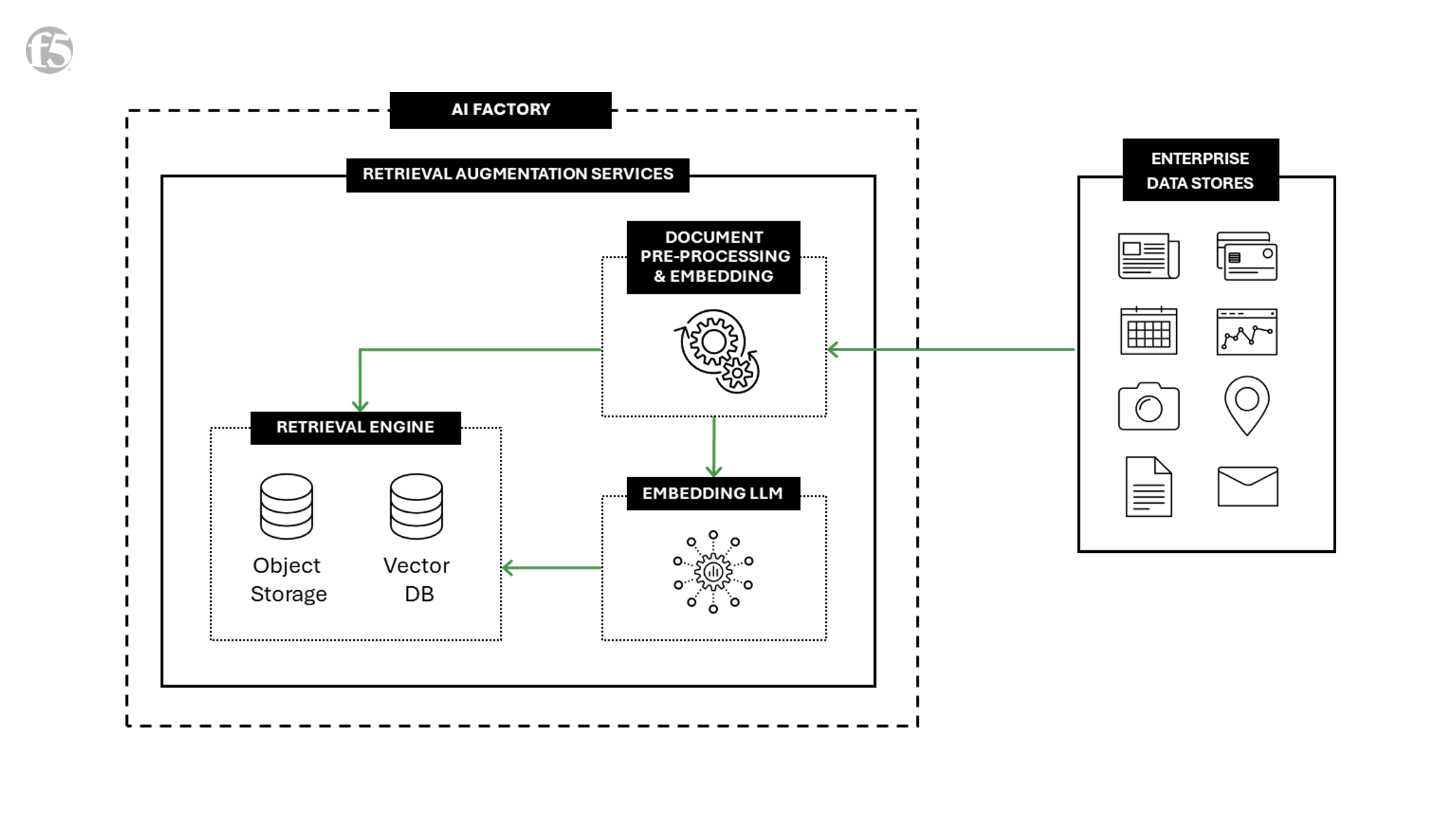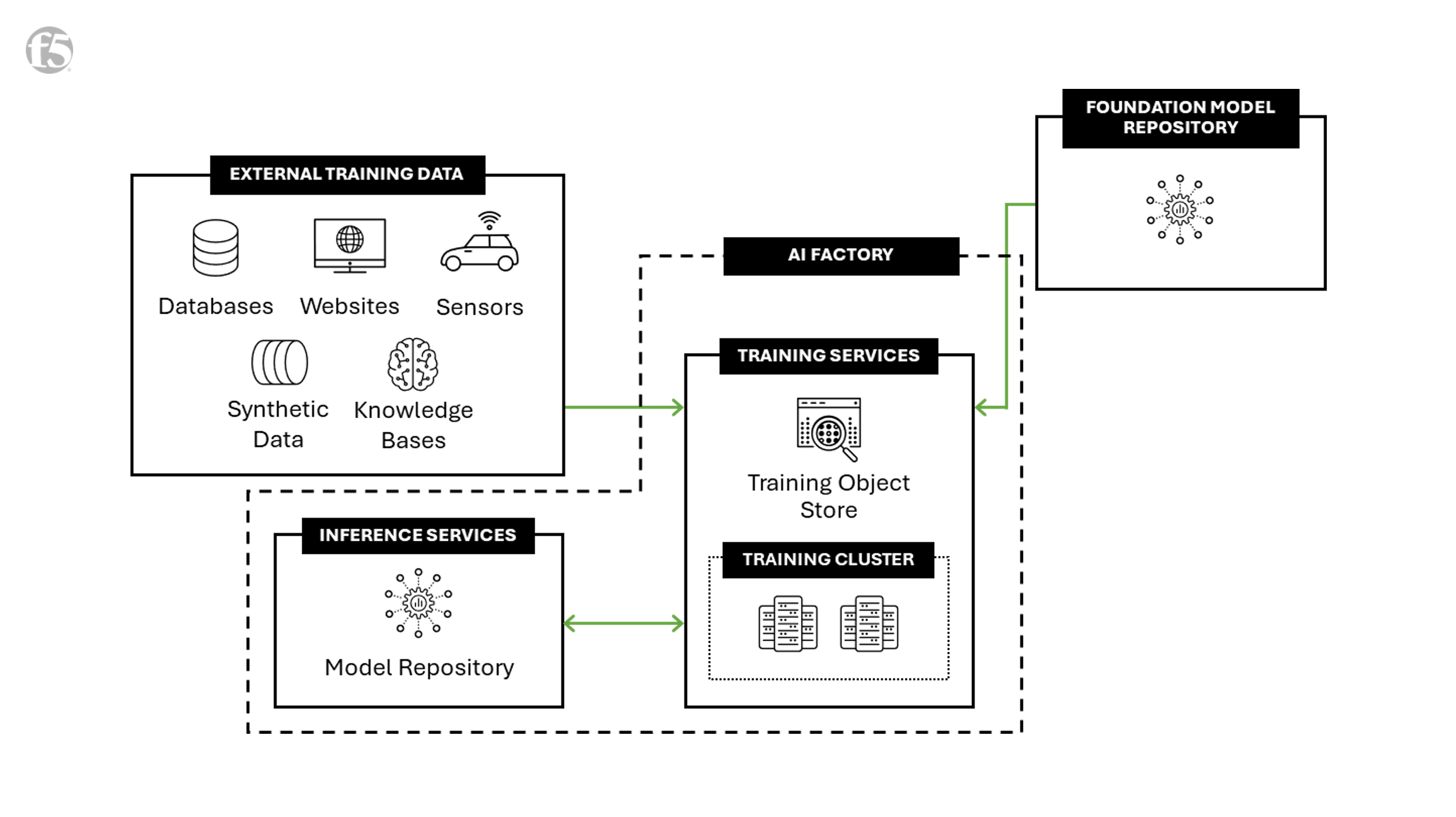엣지 데이터 소스를 AI 팩토리에 최적으로 연결
오늘날의 AI 시대에 기업은 혁신을 추진하고, 효율성을 개선하며, 경쟁 우위를 유지하는 데 더욱 주력하고 있습니다. 이러한 변화의 핵심은 AI 공장이라는 개념이다. AI 팩토리 시리즈의 첫 번째 기사 에서 우리는 AI 팩토리를 대용량, 고성능 학습 및 추론 요구 사항을 처리하는 대규모 저장소, 네트워킹 및 컴퓨팅 투자로 정의했습니다. 최신 공장이 멀티클라우드 환경의 에지 데이터 소스에 연결되어 학습, 미세 조정, 검색 증강 생성(RAG)이 이루어지면 AI의 잠재력이 극대화됩니다. AI 팩토리에서 에지 데이터 소스로의 연결을 구축하면 조직은 RAG를 통해 모델 학습, 미세 조정 및 추론에 대한 접근성을 개선할 수 있습니다.
AI 팩토리에 데이터 연결의 과제
이러한 과제는 서로 다른 시스템을 통합하고 데이터가 생성되는 엣지에서 데이터를 처리하여 RAG를 통한 훈련이나 추론을 수행하는 AI 팩토리까지 효율적이고 안전하게 데이터를 이동하는 데 따른 복잡성에 있습니다. 안전하고 최적화된 네트워크가 없다면 기업은 지연 문제, 보안, 비효율성 등의 위험을 안고 있으며, 이는 기업의 비즈니스 영향을 실현하고 AI 팩토리 투자에 대한 ROI를 확보하는 데 방해가 될 수 있습니다. 이러한 문제는 끊임없이 증가하는 데이터 볼륨과 AI 공장 내외부의 실시간 처리 필요성으로 인해 더욱 복잡해집니다.

RAG Corpus Management를 위해 독점 데이터를 수집하고 처리합니다.
기업은 AI를 활용하여 내부 효율성을 높이고 시장을 차별화할 수 있는 제품을 개발합니다. 회사 내부적으로 AI는 운영을 간소화하고, 일상적인 업무를 자동화하고, 의사 결정을 개선하는 실시간 통찰력을 제공할 수 있습니다. 외부적으로 혁신적인 AI 기반 제품을 개발하면 기업은 고객에게 고유한 가치를 제공할 수 있습니다. 이러한 목표를 달성하려면 보안을 손상시키지 않으면서도 고속 데이터 전송을 지원하는 네트워크가 필요합니다. 네트워크 인프라를 최적화하면 혁신 주기를 단축하고 효율적인 데이터 처리를 통해 운영 비용을 절감하여 비즈니스 목표에 부합할 수 있습니다. 기업은 견고하고 유연한 네트워크 기능에 투자함으로써 시장 변화에 신속하게 대응할 수 있는 입지를 확보할 수 있습니다.
AI 공장을 엣지 데이터 소스에 연결하는 것은 내부 운영과 제품 개발 모두에 매우 중요합니다. 내부 효율성을 높이기 위해 지연 시간을 줄이면 데이터가 출처에 가까운 곳에서 처리됩니다. 강화된 보안 제어 기능을 통해 네트워크를 통해 이동하는 민감한 내부 데이터를 보호하고 침해 및 규정 위반 위험을 완화합니다. 차별화된 제품을 구축할 때, 확장 가능한 네트워킹 솔루션을 사용하면 기업이 다양한 데이터 사일로에서 데이터를 수집할 때 증가하는 데이터 부하를 처리할 수 있습니다.
AI 트래픽을 위한 네트워크 최적화 실패의 위험
네트워크 최적화를 다루지 않을 경우 상당한 위험이 따릅니다. 기업들은 데이터 병목 현상, 취약성 증가, 효과적인 운영 확장 불가능 등의 문제에 직면할 수 있습니다. 이러한 문제는 AI 애플리케이션의 다운타임으로 이어질 수 있으며, 그 결과 고객 신뢰가 떨어지고 궁극적으로 경쟁력이 약화됩니다. 기업이 AI 인프라 구축에 집중하지 않는다면 이미 경쟁에서 불리한 입장에 처해 있을 수 있습니다.
AI 팩토리와 엣지 데이터 소스 간의 최적의 연결은 AI 시대의 핵심 요소입니다. 네트워크 인프라를 최적화함으로써 조직은 전례 없는 수준의 효율성, 혁신, 경쟁력을 확보할 수 있습니다. 위험과 과제는 상당하지만 전략적 계획과 이러한 기초 계층에 대한 투자를 통해 관리할 수 있습니다.
디지털 환경이 계속 발전함에 따라, 문제는 기업이 AI 팩토리와 엣지 데이터 소스 간 네트워크 연결을 최적화하는 데 투자해야 하는지 여부가 아니라, 얼마나 빨리 적응하여 기회를 잡을 수 있느냐는 것입니다. 끊임없이 증가하는 AI의 속도에 맞춰 움직이는 기업은 현재 운영을 개선할 뿐만 아니라 지속가능한 성공을 위한 기반을 마련할 수 있을 것입니다.
최적화된 AI 팩토리 네트워킹의 장점
AI 공장을 엣지 데이터 소스에 연결하는 기업은 비용을 절감하고 효율성을 높이는 데 도움이 될 수 있습니다. 이러한 내부 최적화는 더 나은 서비스 제공과 고객 만족도로 이어집니다. 동시에, AI 기반 제품 개발을 가속화하여 새로운 제품을 더욱 빠르게 시장에 출시하고 고객 요구에 보다 효과적으로 대응할 수 있습니다. 실시간 통찰력을 활용하면 제품과 서비스를 개인화하고 시장에서의 지위를 강화할 수 있습니다.
AI의 핵심 기반으로 네트워크에 투자하는 것은 단순히 기술 동향에 발맞추기 위한 게 아니라, 내부적 성공과 외부적 경쟁력을 모두 갖추기 위한 미래 지향적 전략입니다. 최적화된 네트워크 인프라는 예측 분석 및 자동화된 워크플로와 같은 내부용 고급 AI 애플리케이션의 배포를 지원하여 효율성과 의사 결정을 향상시킵니다. 또한, 이를 통해 혁신적인 AI 기반 제품과 서비스의 개발이 가능해져 기업은 IoT 통합과 같은 새로운 기술을 활용할 수 있습니다. AI 시대는 기하급수적으로 진화하고 변화하고 있으며, 기업은 이를 앞서나가야 합니다.
AI 팩토리가 데이터에 액세스해야 하는 이유는 무엇입니까?
AI 팩토리와 엣지 데이터 소스의 융합은 세계 최고의 AI 혁신 기업들이 운영하고 경쟁하는 방식에 혁신적인 변화를 가져옵니다. 최적의 연결성은 이러한 융합을 가능하게 하는 핵심 요소입니다.

AI 팩토리에 특화된 모델 학습 및 미세 조정을 위한 데이터 수집.
AI에 투자하는 조직은 데이터 이동을 지원하기 위해 네트워크 인프라 투자를 우선시해야 합니다. 여러 클라우드 환경에서 분산된 데이터 소스를 연결하면 조직은 실시간으로 변경되는 이 데이터를 다양한 사용 사례에 활용할 수 있습니다. 여기에는 특정 맞춤 사용 사례에 대한 모델 학습 및 세부 조정, RAG를 통한 추론 중 기본 모델 보완 등이 포함됩니다. AI 팩토리에 데이터를 모으는 것은 연결된 기업 생태계를 만들어내며, AI 팩토리, 엣지 데이터, 최적화된 네트워크 간에 최적화된 데이터 흐름을 제공합니다.
F5로 구동되는 엣지 연결
AI 공장을 엣지 데이터 소스에 최적이고 안전하게 연결하는 것의 중요성은 지나치게 강조할 수 없습니다. 이는 사업 목표에 부합하고, 기술적 우위를 제공하며, 경쟁 우위를 제공하는 전략적 투자입니다. F5 기술은 데이터 연결과 이동성을 지원하여 보안을 강화하고 지연 시간을 줄이며 확장 가능한 성능을 제공합니다. 최첨단 AI 솔루션을 도입한 기업은 최적화된 지능형 네트워크 인프라가 제공하는 기회를 활용하여 각 산업을 선도하는 데 유리한 입장에 있게 될 것입니다.
F5의 AI에 대한 집중은 여기서 끝나지 않습니다. F5가 모든 곳에서 AI 앱을 보호하고 제공하는 방법을 살펴보세요.
AI 공장에 대해 자세히 알고 싶으신가요? AI 팩토리 블로그 시리즈에서 다른 시리즈를 탐색해 보세요.
